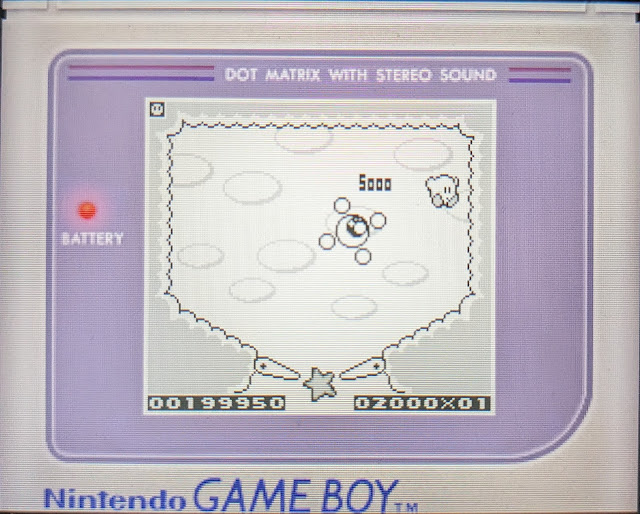Kirby's first spinoff game (of many) is Kirby's Pinball Land, released on the Game Boy near the end of 1993. It combines classic pinball with elements from the popular Kirby games. It could almost be considered a sequel to Revenge of the 'Gator, another Game Boy pinball game made by HAL Laboratory.
There are three tables to choose from: Whispy (the tree, misspelled "Wispy"), Kracko (the cloud), and the bomb-throwing Poppy Bros. Interestingly, you can travel between tables during the same game by beating that table's boss or catching a warp star. Once a boss is defeated (by hitting it repeatedly), you cannot re-enter that table. If you beat all three—not easy!—Kirby faces King Dedede as the final boss. I like how this mixes up the traditional pinball experience with the level-based video-game experience.
The table layouts are basic and adorned with enemies from the Kirby games. Kirby bounces around, racking up points, and you use the flippers to keep him afloat. The d-pad is used to activate the left flipper, while A moves the right flipper. You can shake the table by pressing B or ↑ or → on the d-pad.
Each table is divided into three vertical screens. When Kirby — who acts as the ball, in case you hadn't guessed — falls down, he moves to the screen below. The game uses transition screens that combine the top and bottom of two screens to create the effect of one continuous table. Each table also has a bonus screen and a boss screen, which Kirby can enter by grabbing a warp star. The topmost screen's star goes to the boss, the middle star to the bonus room, and the bottom star back to the table select. The mechanism for triggering a warp star is different on each screen. For example, in the Poppy Bros. table Kirby must make three eggs hatch to trigger the boss star. Stars disappear after a few seconds, so you have to act fast! The bonus rooms are reminiscent of the bonus room in the original Pinball on the NES. My favorite is a breakout clone in Whispy Woods.
An interesting feature is that, when Kirby falls down into the drain, instead of automatically losing a life, you have a chance to launch him back up. The mechanism is the same used in the bonus screens from Kirby's Adventure. Kirby lands on a springboard: if you press A near its nadir, it will launch him with enough velocity to return to the table. The spring goes low the first time, giving you plenty of time to push A. Each time thereafter it goes less far down, making the timing more precise. You get three lives (balls) and can earn extra lives by spelling EXTRA on the table-select screen if you've defeated a boss.
There's nothing too special here: it's pinball with Kirby. The graphics are simple, but each table has its own background music. I like the multiple tables with bosses and the fact that you can beat the game, which is normally impossible in pinball. This gives you something to aim for besides a high score. The cartridge includes a battery backup for saving your scores, which is great! It even lets you save in the middle of play (press SELECT), which is convenient for a handheld game.
Kirby's Pinball Land is a good Game Boy game. A portable system is well suited to the short-session nature of pinball. The heavy challenge of completing all three tables and four bosses on a single "quarter" (so to speak) gives it greater longevity. Not a bad little game!
Linked Reviews
"It's too crowded and restrictive to serve as a fun score attack game, and it's too loose and randomised to feel like a proper Kirby outing as well."
— Philip J. Reed, Nintendo Life, 4/10
— Philip J. Reed, Nintendo Life, 4/10
"The ball movement is smooth and true. Gameplay is consistently involving and just plain fun."
— Steve Averett, IGN, 8/10
— Steve Averett, IGN, 8/10






Comments
Post a Comment